The UEFA Champions League semi-finals kicked off this week with Real Madrid being extremely lucky to come away with a 1-1 draw at home against Chelsea. The second tie of this round sees Paris Saint-Germain and Manchester City lock horns, with both teams hoping that this will be the season where they win their maiden Champions League trophies.
PSG started the game strongly through Marquinhos’ goal, and Manchester City were outplayed in the first half. However, Pep Guardiola’s tactical tweaks at half-time allowed City to slowly begin to dominate the contest, and they managed to score twice from set-piece situations to take back a 2-1 lead to Manchester for the second leg, with the added advantage of having scored two away goals.
This tactical analysis will break down both sides’ tactics and explain how Pep’s half-time changes made such a big difference to this match.
Lineups
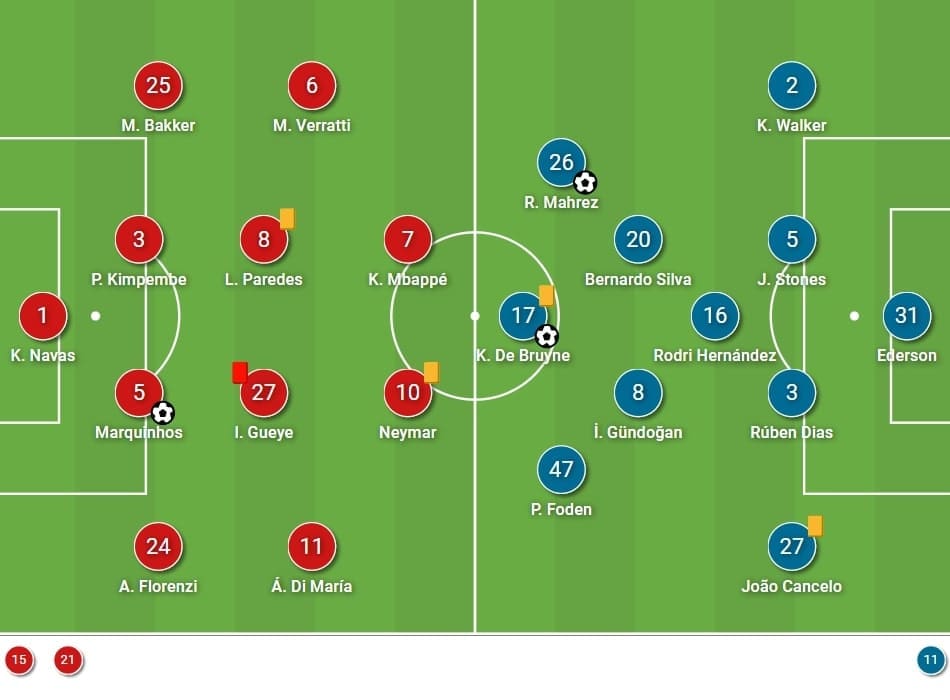
PSG were able to bring back two key players in Marquinhos and Marco Verratti who had missed the second leg of their quarter-final against Bayern Munich. Mauricio Pochettino made changes at full-back as well, with Mitchell Bakker and Alessandro Florenzi coming into the XI ahead of Laywin Kurzawa and Colin Dagba.
Pep’s preferred system at the moment seems to be a strikerless one, as he once again chose Riyad Mahrez, Phil Foden and Kevin De Bruyne as the attacking midfielders with Bernardo Silva in support. Sergio Aguero, Gabriel Jesus and Raheem Sterling were all left on the bench.
Suboptimal defensive system
PSG began the game in an impressive manner, and were able to dominate possession and territory against City for the first 30 minutes or so, which is no mean feat. The biggest reason for this was City’s ineffective press, which allowed the home side to move the ball quickly up the pitch with just two or three quick passes.
Guardiola had highlighted how dangerous Kylian Mbappe, Neymar and Angel di Maria could be on the counter-attack, which is why İlkay Gündoğan and Rodri were usually positioned quite deep, to provide more security to the City centre-backs. This essentially meant that City were often in a 4-2-4 shape while pressing, as can be seen in the image below.
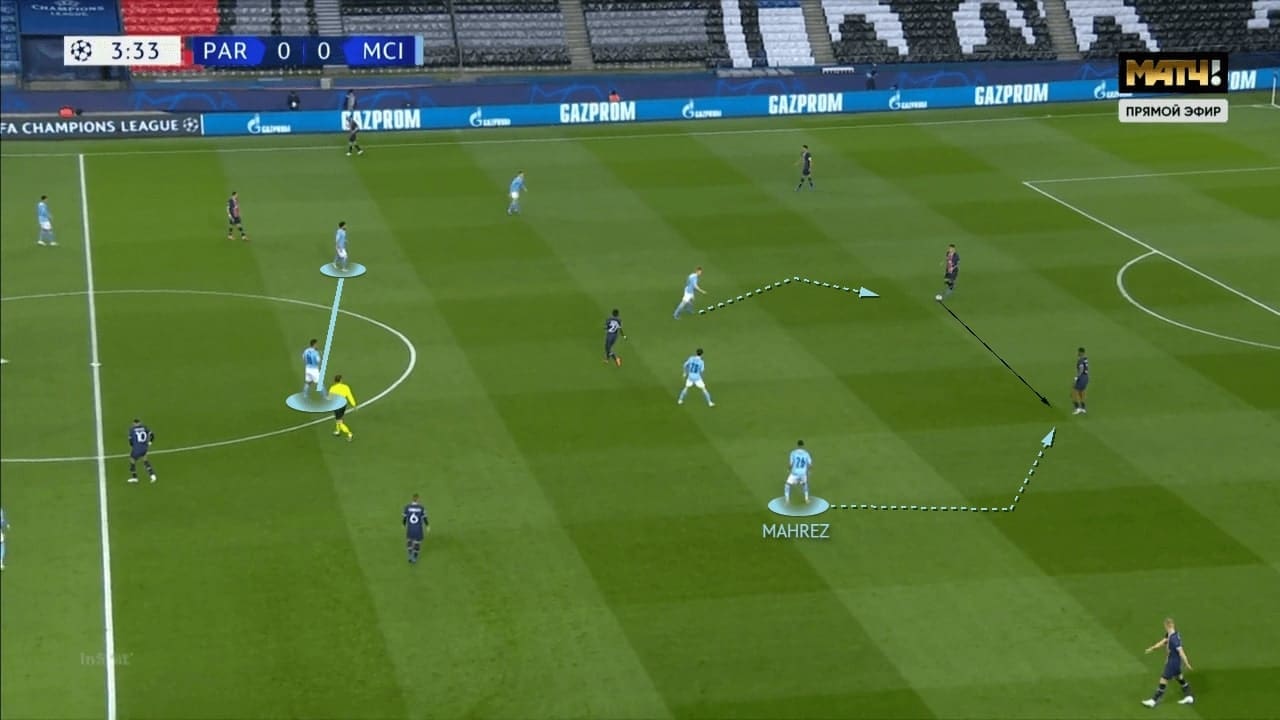
De Bruyne and Mahrez were the two players who would advance and press the PSG centre-backs, curving their runs to try and prevent easy passes into midfield, while Bernardo Silva stayed slightly deeper and blocked central passing lanes. However, the two advanced City players had to cover a lot of ground, and this gave Marquinhos and Presnel Kimpembe time and space to pick their passes, which meant that they could then easily find teammates in space.
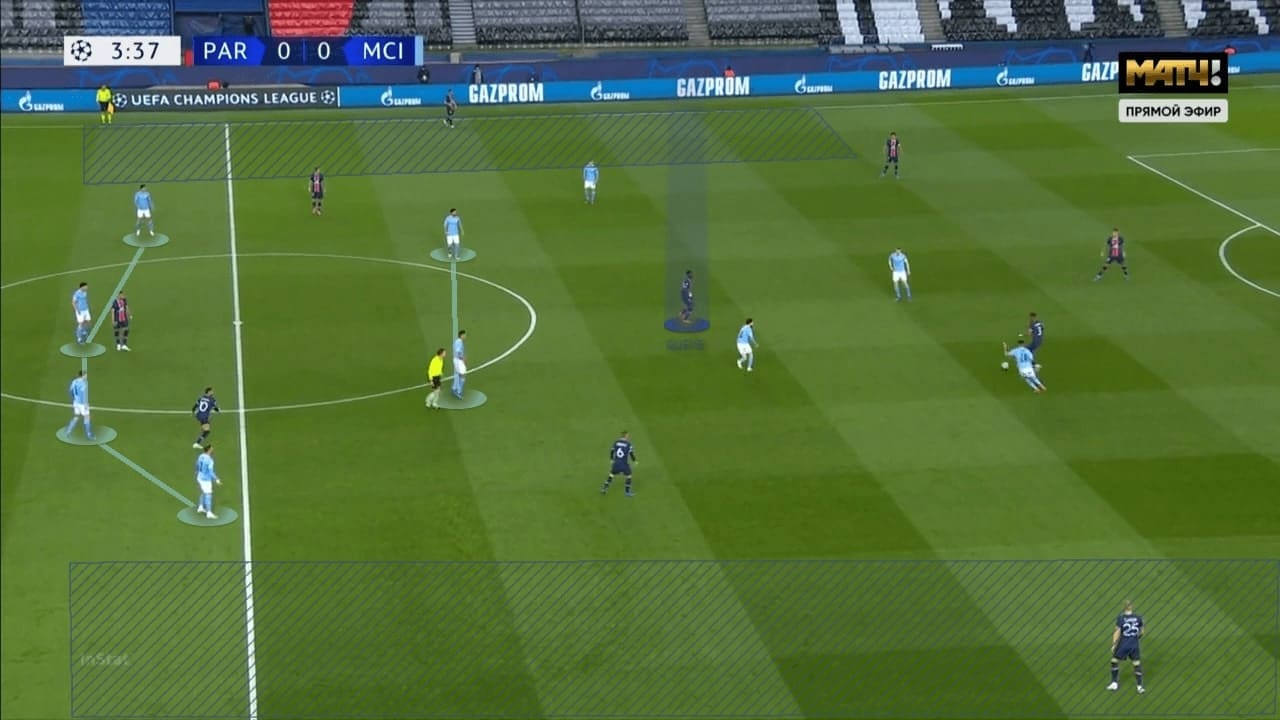
The above image is a good example of City’s poor pressing structure. Mahrez is too late at closing down Kimpempe, while Silva is also not close enough to Idrissa Gueye to shut the pass down. We can see how the PSG full-backs, who are staying wide, have acres of space to advance into, due to the central positioning of the City wingers and full-backs. This was done to ensure that Mbappe and Neymar did not find space centrally to run into, but the wide spaces were opened up as a result.
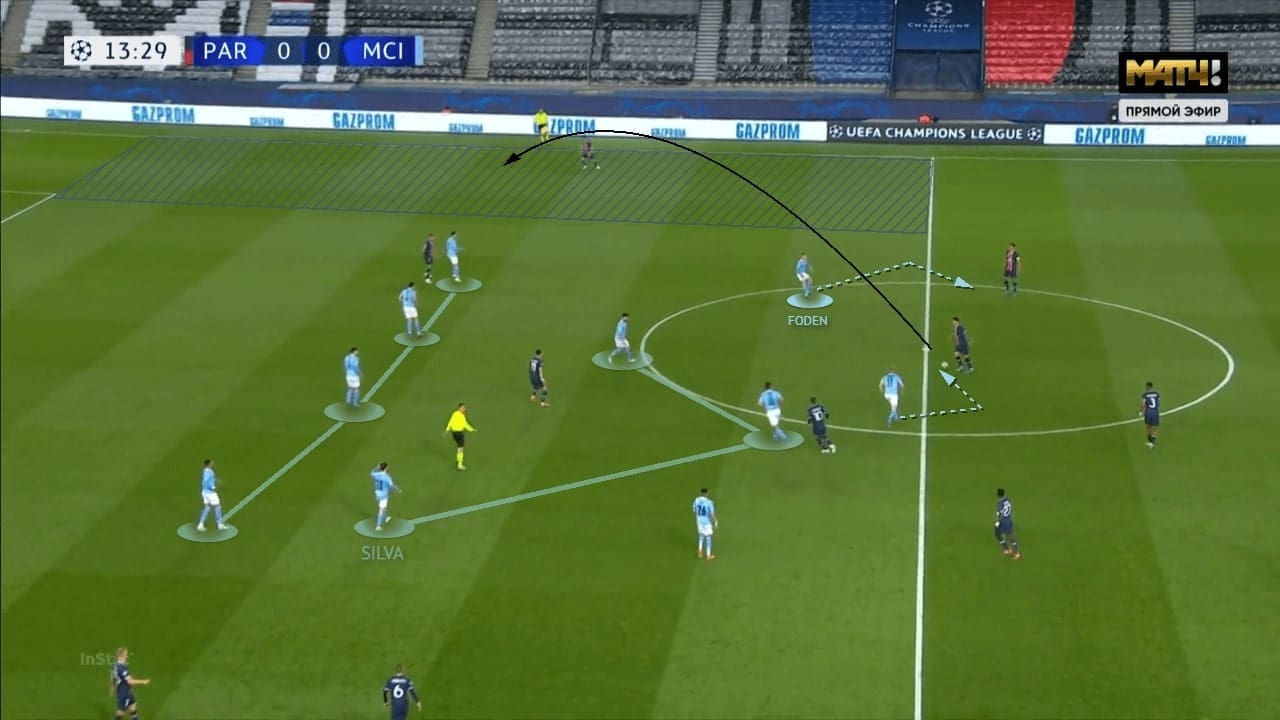
City were also slightly passive, sitting off their opponents on occasion, which also gave PSG the time to circulate the ball quickly.
Silva’s positioning here, just a few yards ahead of Kyle Walker in the right half-space, shows Guardiola’s insistence on trying to deny PSG’s dangerous attackers any space between the lines. However, this is also why Foden, De Bruyne and Mahrez had to press the centre-backs, vacating the flanks as a result.
We can see City’s compact back four in this image as well, which is happy to concede space out wide. Marco Verratti made ample use of this by drifting out to the left on multiple occasions, while Neymar was also involved in switching the ball out wide to the full-backs. Note how Joao Cancelo has to stay central here due to Mbappe’s positioning, which means that Florenzi has the entire flank to gallop into.
Early deficit, early changes
While PSG’s goal was not a direct result of these issues in City’s pressing strategy, Guardiola did realize this fairly quickly and made changes, which were evident from around the half-hour mark.
The biggest change was that De Bruyne and Silva, the two nominal central attackers, were the ones pressing the PSG centre-backs, while Mahrez and Foden stayed deep and wide to make sure that the home side’s full-backs were not able to enjoy the freedom of the flanks. However, this decision did have its risks, as this meant that City were now not prioritizing covering the central spaces, and they were leaving themselves open to PSG’s formidable pace and ability on the transition.
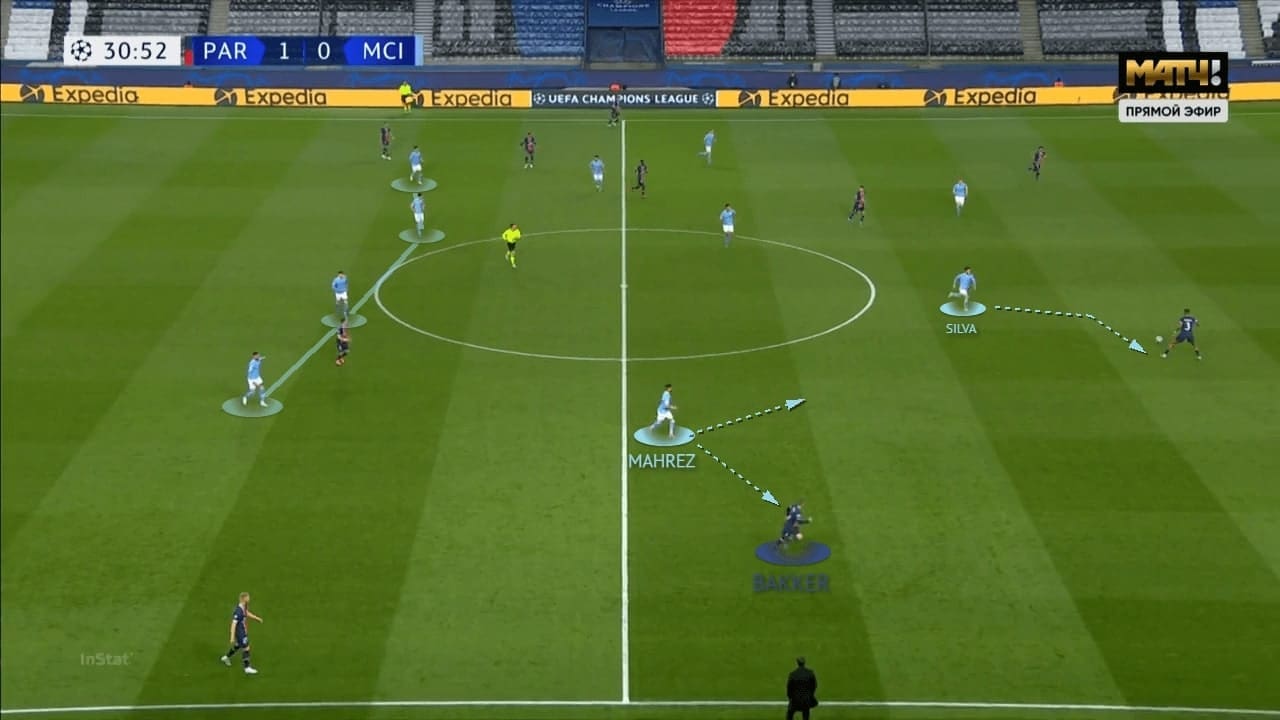
We can see an example of this switch in the image above – Silva and De Bruyne are central, with the ball-near attacker pressing the centre-back. The direction of the press also changed as a result (from outside-in to inside-out) which made it easier to close off central passing lanes and force PSG to play the ball out wide. The back four’s positioning remained unchanged – staying compact and tight to deny PSG’s front three any vertical spaces to run into.
As mentioned earlier, this tweak meant that while the PSG full-backs were now marked closely by City’s wingers, it did open up vertical passes into the half-spaces from deep. However, PSG rarely played any passes into Neymar or Mbappe’s feet in those sort of positions.
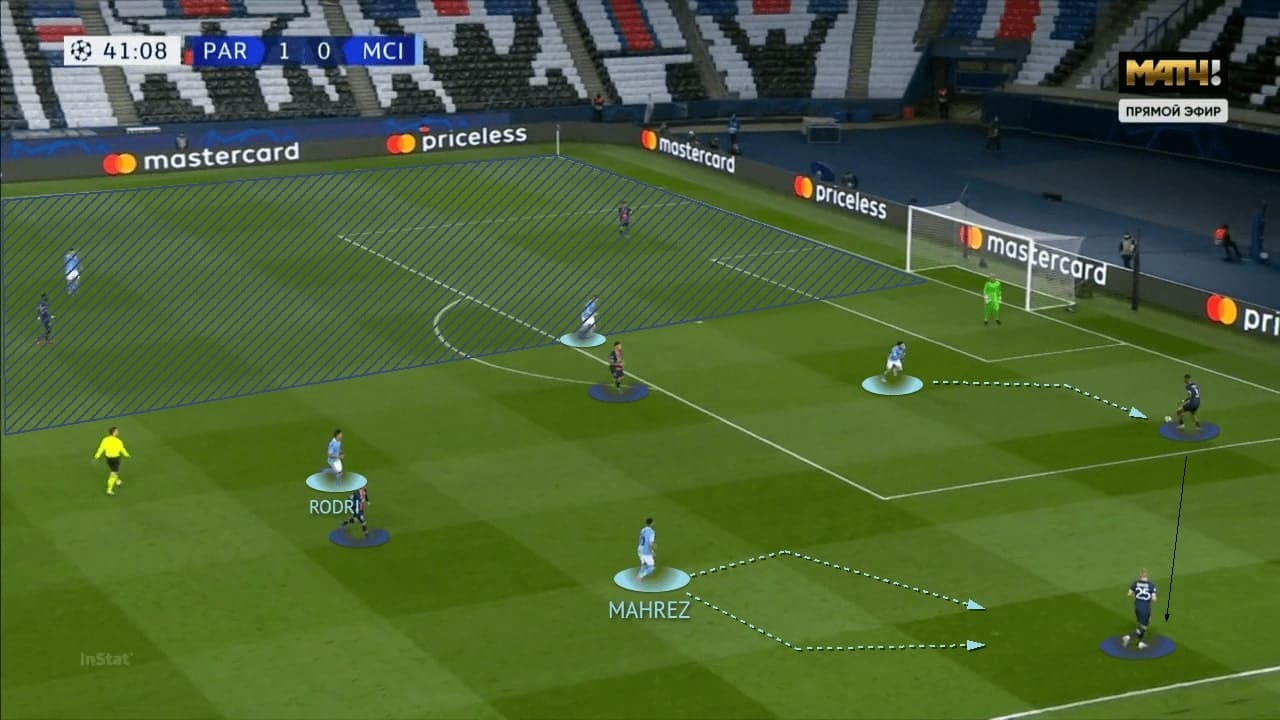
The change also helped City to regain numerical parity on the flanks when pressing, and this directly led to them regaining the ball high up the pitch and setting up Foden for a chance which he could only shoot straight at Keylor Navas.
This image shows the build-up to that chance. Silva’s run forces Kimpembe to play the ball to Bakker, which removes the opposite side of the pitch from the game at that moment. Mahrez is also ready to press Bakker when Kimpembe releases the pass, with De Bruyne marking Leandro Paredes and Rodri stepping up to shadow Verratti as well. A 4v4 is created, and City were able to win the ball back and create a dangerous chance as a result.
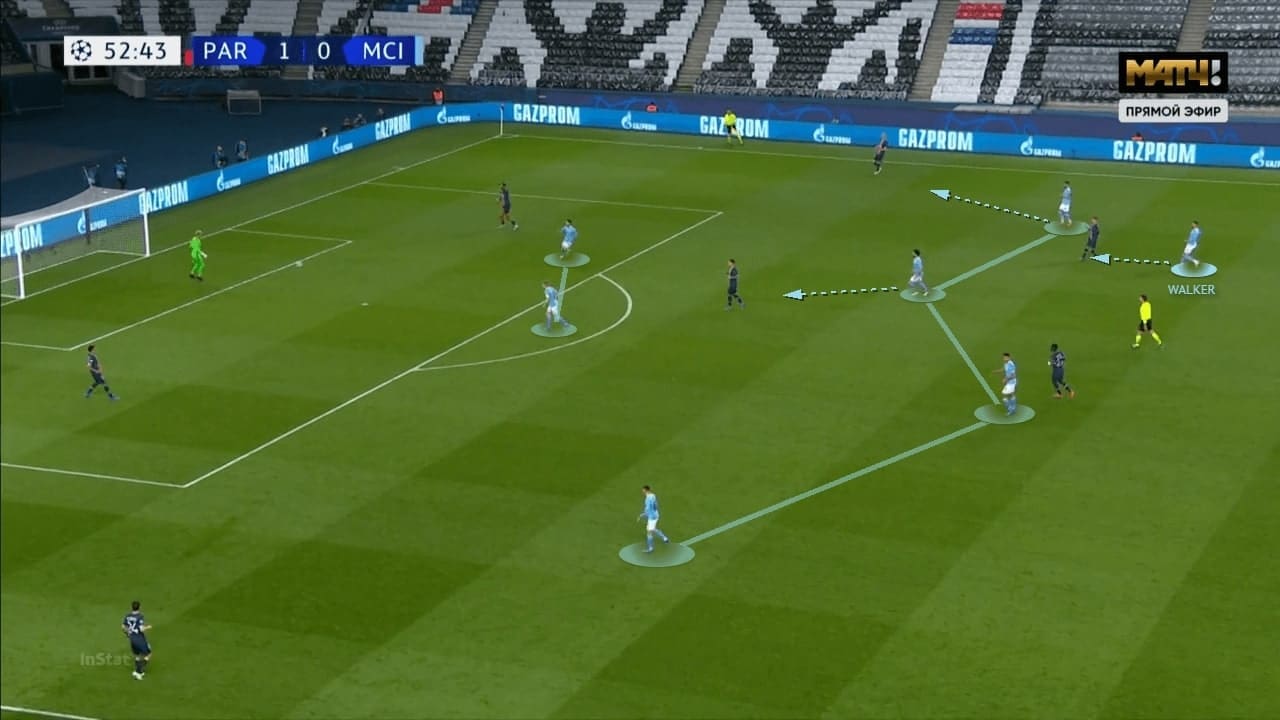
The away side were also given a little more flexibility in their positioning and movement off the ball, with the back four, for example, being allowed to step up and close down players and spaces rather than stay deep. This is one of the reasons why the likes of Walker and Dias were often in the PSG half of the pitch during the second half of the game.
City’s press was now concentrated on forcing PSG wide and trapping them there, while also staying vertically compact. We can see City’s staggered 4-4-2 shape in this image, where Gundogan is positioned higher than Rodri, for example, to be able to press Paredes if needed. Walker is also quite high up the pitch, sticking tight to Mbappe, as he was probably the only player in the City XI who could keep up with the Frenchman if he managed to turn and spin past him. PSG did not react or adjust to this change of strategy, which meant that City were a lot more dangerous and effective in the second half.
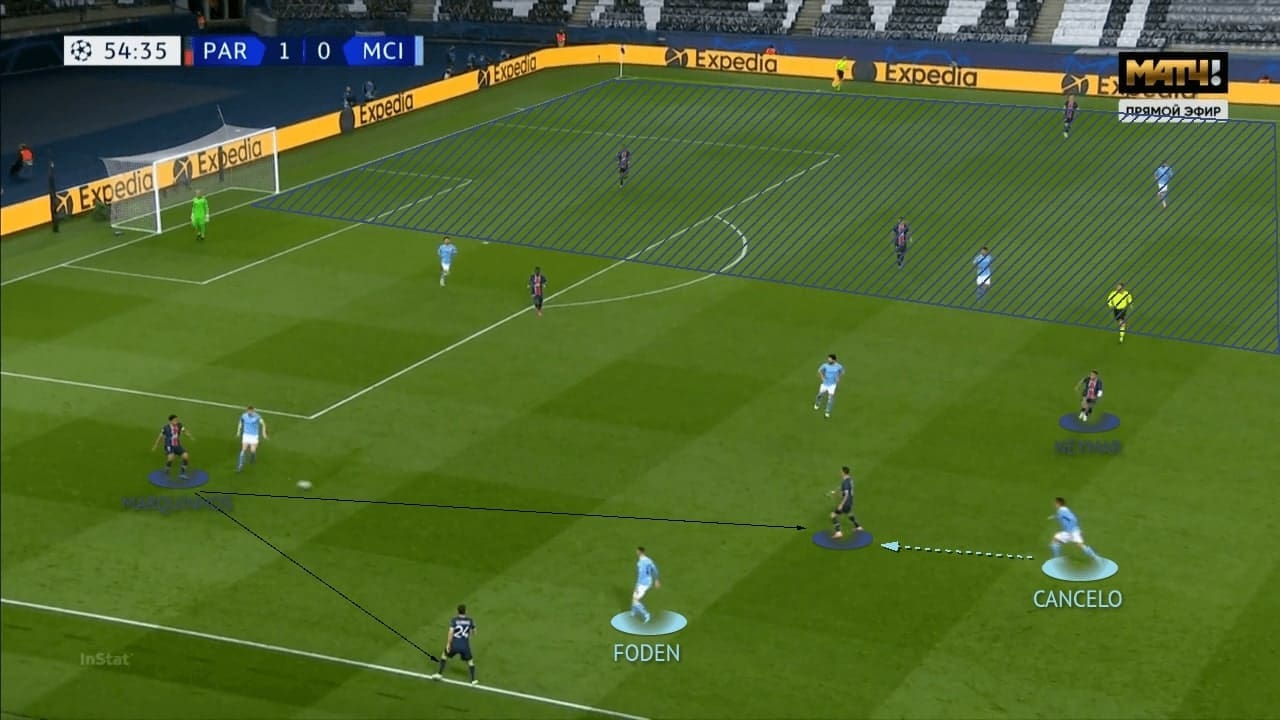
This image is an example of City’s full-backs pressing high. City were able to successfully force PSG to pass down the right, despite the home side having a numerical advantage on the opposite side. De Bruyne’s presence forces Marquinhos to release the pass to Di Maria, which is the trigger for Cancelo to press him.
We can see how Foden is staying wide to monitor Florenzi, which rules him out as a passing option while Gundogan and De Bruyne are cutting off the passing angle to Neymar, who has dropped into midfield and could potentially have isolated Dias and John Stones in a 2v2 along with Mbappe if he had been found here. This shows the change in effectiveness of City’s press, as Cancelo won the ball back high up the pitch in this scenario. Pep’s side managed to maintain this intensity throughout the second half, and he even brought Oleksandr Zinchenko on for Cancelo, who had been booked earlier, to ensure that City could still press aggressively without having to worry about a potential sending-off.
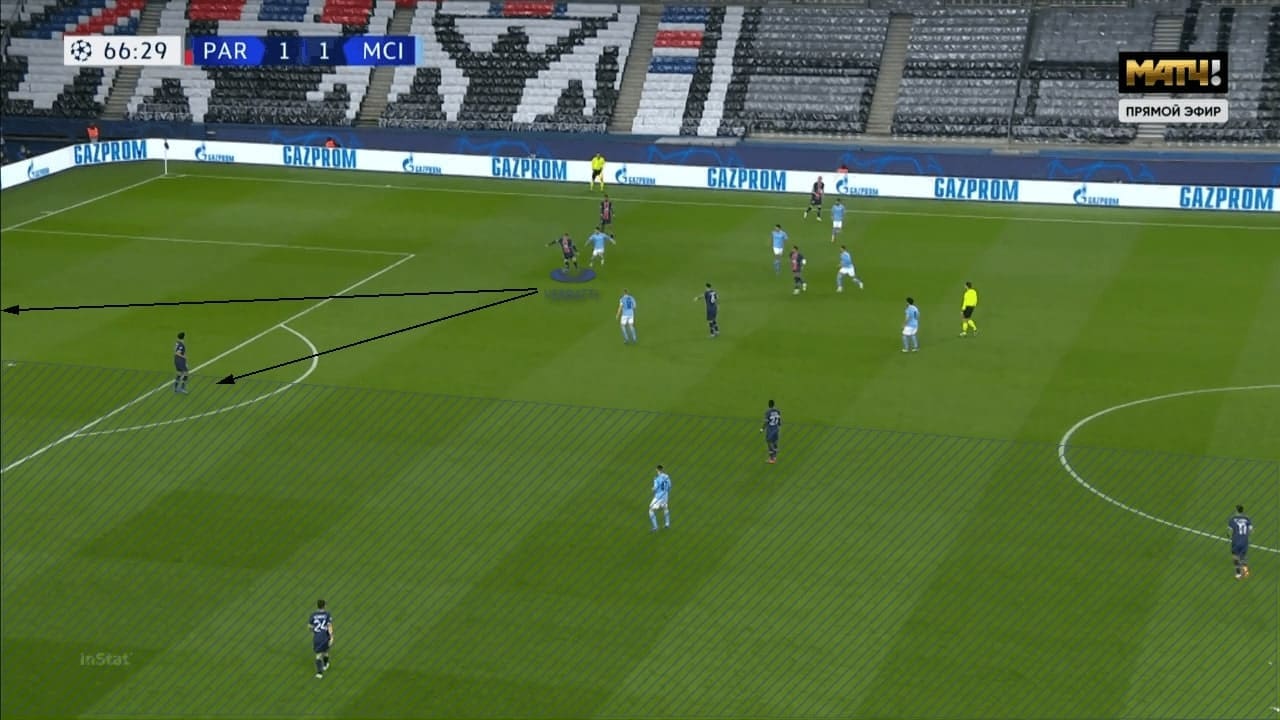
This is not to say that City’s press was perfect – they did make mistakes, but PSG failed to capitalize on them, and in general, the home side were unable to pick the right passes during the build-up phase in the second half. Marco Verratti’s performance was emblematic of this – the Italian was brilliant in the first half, but faded in the second period, making a number of errors and losing possession in dangerous areas.
This image shows one such example, where Verratti has the option to play a simple pass back to either Navas or Marquinhos when under pressure here, with the play then being switched to the right where PSG had space. However, he chose to turn and dribble past his opponents – there were six City players on that side of the pitch, and it was no surprise that he lost possession here.
Finding the solution in the attack
The away side also needed to change their attacking setup to get something from this game – Pep had started quite conservatively in this regard as well, but as with his approach off the ball, he was able to find a solution which increased their attacking threat as well.
It can also be argued that the initial setup itself was fine, and the reason it did not work was due to the lack of execution on the pitch.
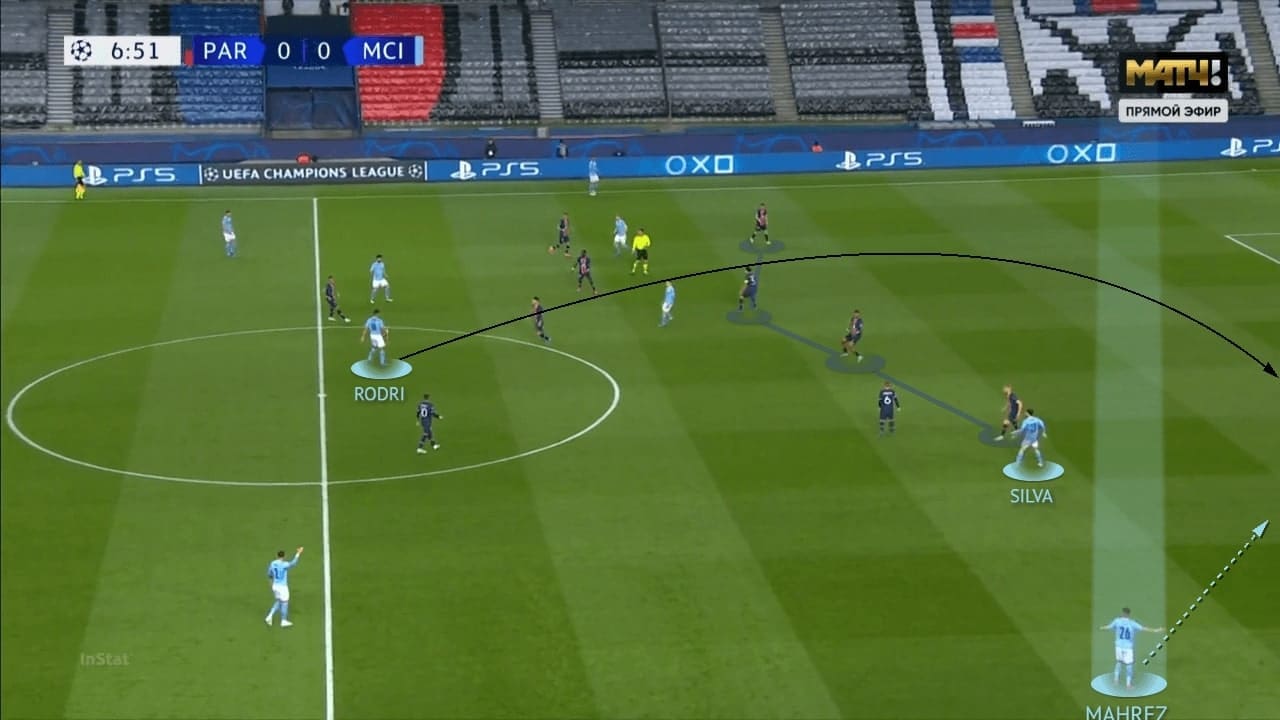
Playing Cancelo at left-back meant that Rodri and Gundogan would stay deep and be an active part of the build-up phase, as the Portuguese full-back does not invert and come into midfield from the left as he does from the right. PSG were content to sit back in a rough 4-4-2, with Neymar and Mbappe left high up the pitch to create counter-attacking opportunities. They, like City, were focused on denying central space, which meant that the flanks were open to attack.
City focused a lot of their attacks down their right flank, trying to take advantage of Bakker who was considered a weaker opponent than Florenzi on the opposite side. Gundogan, De Bruyne and Cancelo would all stay on the left, drawing PSG over to that side, before Rodri or one of the other players would switch the ball to Mahrez, who stayed wide on the right to receive in space. As we can see in this image, they also tried to overload Bakker by using Silva to pin him centrally and free up space for Mahrez, and it was only the poor execution of that pass to the Algerian winger which prevented them from rapidly advancing to the final third down that side.
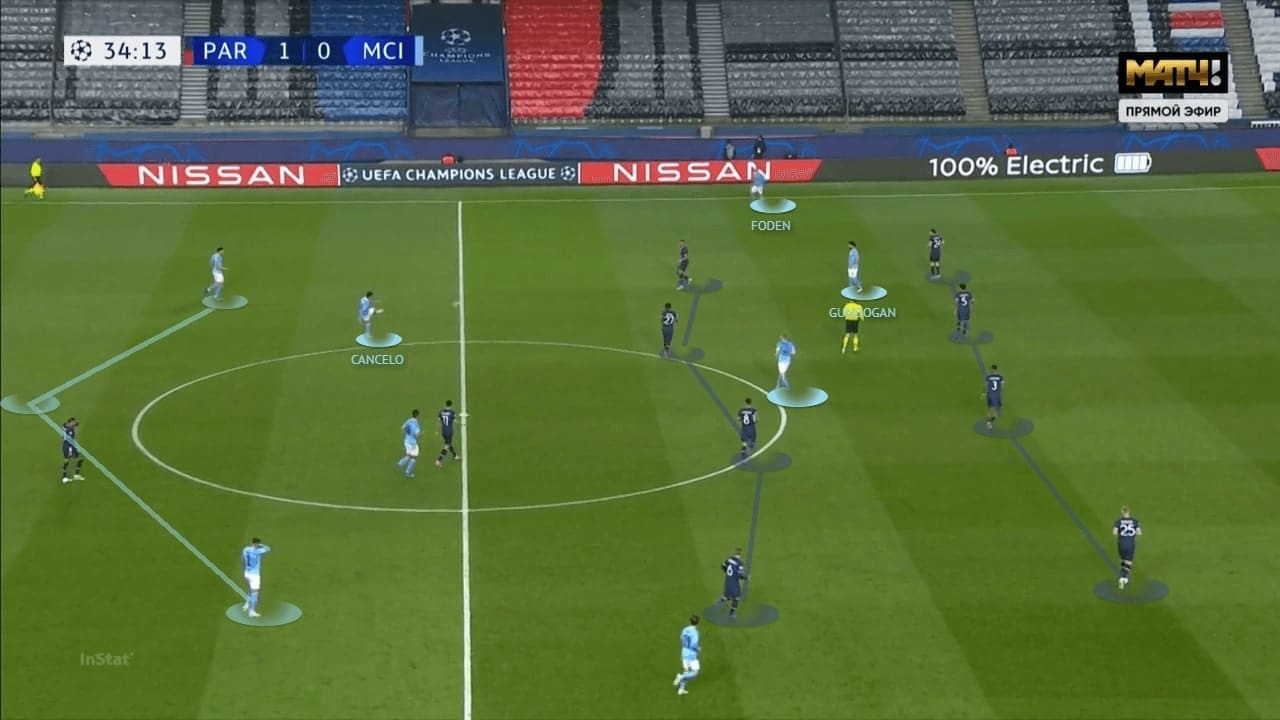
Pep’s tweak in this regard involved getting Cancelo to invert and come into midfield, which freed Gundogan up to advance up the pitch while maintaining City’s 3-2 shape in the build-up. They also tried to increase the tempo of their play by playing short and quick passes rather than attempting diagonal passes to the flanks. Foden and Mahrez stayed wide to maintain width, which also allowed Gundogan and De Bruyne to pick up central positions between the lines.
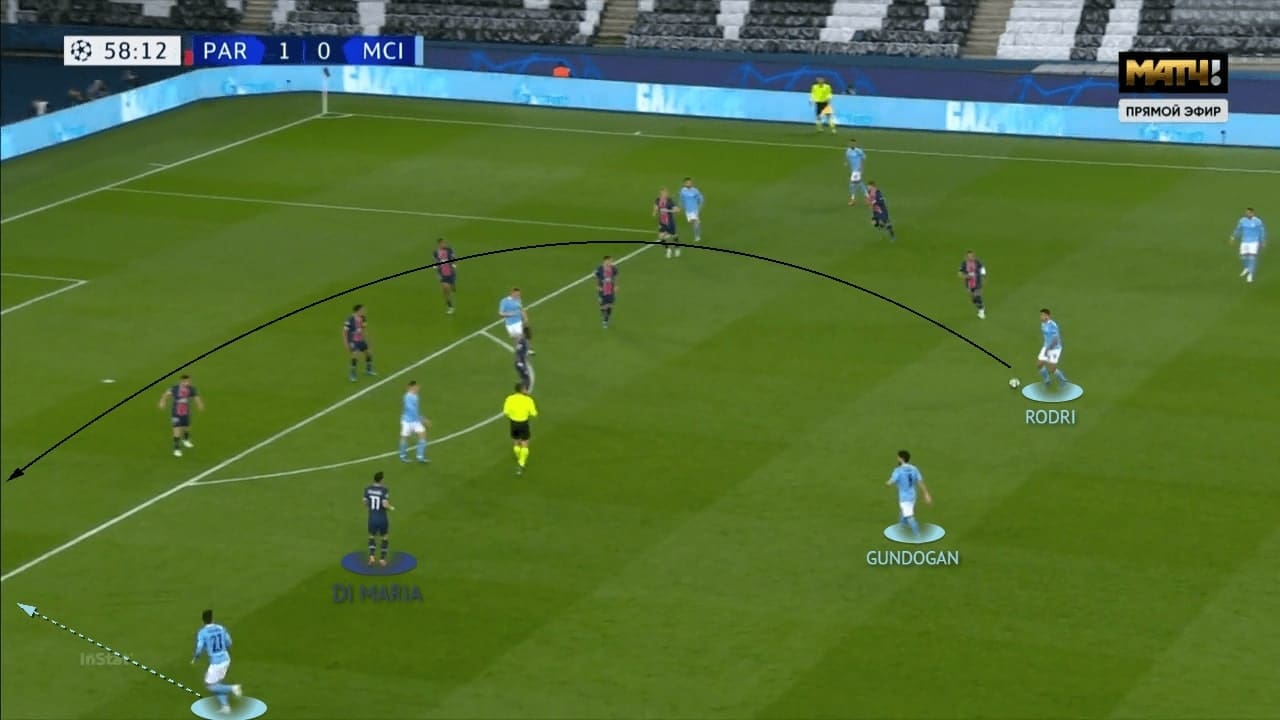
However, it was interesting that Pep reverted to the original system at half-time, with Gundogan once again dropping back to play as a pivot with Rodri. However, the changes now were that Foden was allowed to roam across the width of the pitch rather than sticking to a left wing berth, and Cancelo and Walker began to offer width and overlapping runs. This also drew Di Maria deeper as he was forced to track the City left-back, and reduced his counter-attacking threat to an extent, although the 33-year-old was still able to get away from City’s press, and almost played Mbappe in with a perfect through ball that Ederson had to come out and clear.
Final remarks
Despite starting the game quite well, PSG were disappointing in the second half, as they became passive and casual in their approach. Their build-up play was poor, which allowed City to regain possession time and again in their half, while PSG were also unable to manage the game at an emotional level. Gueye was sent off for an unnecessary tackle on Gundogan, while Paredes received a booking for kicking the ball away in frustration after a decision went against PSG. While they do have the quality to mount a comeback in Manchester next week, it will be extremely difficult to score twice against the Premier League champions-elect, and City firmly have one foot in their first-ever Champions League final.





Comments